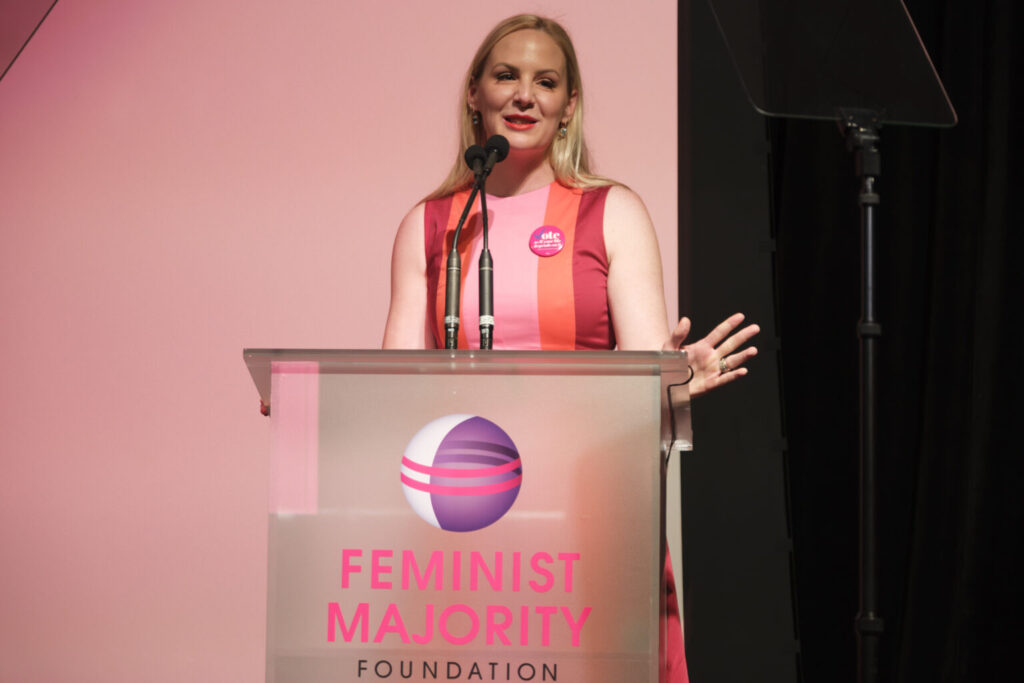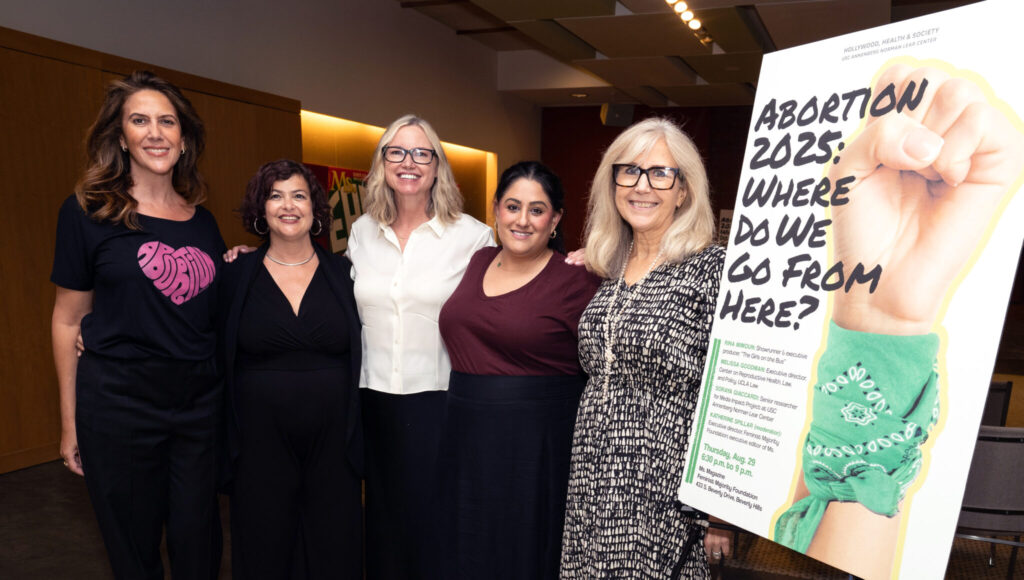The Power of Abortion Storytelling - Ms. Magazine (original) (raw)
A black dress, bought on Amazon, was the small detail that brought home a poignant truth about the challenges women encounter in finding abortion care in a post-Roe America.

Austin Dennard receives the Courage Award at the 16th annual Global Women’s Rights Awards, hosted by the Feminist Majority Foundation, on May 14 in Los Angeles. (Nina Zacuto)
This story was originally published by Hollywood, Health & Society, USC Annenberg Norman Lear Center.
Dr. Austin Dennard, an OB-GYN in Dallas, Texas, knows firsthand how draconian abortion bans create high-risk situations for pregnant patients and providers in Texas.
For Dennard, it’s not only professional—it’s personal. In 2022, she herself had a nonviable pregnancy, in which the fetus she carried had anencephaly, a fatal condition in which the skull and brain do not fully develop, posing a severe health risk to the pregnant woman.
Today, abortions are completely prohibited in Texas. But at the time of Dennard’s fetal diagnosis, Texas’ SB 8 was the law of the land, which banned abortions at five to six weeks gestation, before most women even know they are pregnant. When it took effect—months before the fall of _Roe_—SB 8 was the most extreme abortion ban to take effect in the U.S. since abortion was legalized in 1973. It also had that infamous bounty hunter provision, deputizing private citizens to enforce the law.
Because Texas’ ban didn’t allow for exceptions for the health of the mother or for fatal fetal diagnoses, Dennard—then, already a mother of two—was forced to go out-of-state to terminate her pregnancy.
Dennard told these stories as a part of an Aug. 29 Zoom panel discussion “Abortion 2025: Where Do We Go From Here?” She recounted having to travel from the comfort of her own home, leaving her family and patients behind, staying in a strange hotel room in another city, and the unfamiliar clinical surroundings where the abortion was done.
And the black dress? It was worn on the plane ride home so that, as Dennard said, so that any spotting caused by the procedure “wouldn’t show on her own clothes.”
The panel discussion, presented by Hollywood, Health & Society, a program of the USC Annenberg Norman Lear Center, was held last month at the Ms. magazine offices (also home to Ms.’ publisher, the Feminist Majority Foundation).

(Courtesy of Hollywood, Health & Society, a program of the USC Annenberg Norman Lear Center)
In addition to Dennard, the guest speakers present were:
RINA MIMOUN, most recently the show runner and executive producer on the Max series The Girls on the Bus, which featured a prominent storyline on medication abortion.
MELISSA GOODMAN, the executive director of the Center on Reproductive Health, Law, and Policy at UCLA Law, a think tank and research center created to meet the current national crisis in access to abortion while working towards long-term solutions to advance reproductive justice.
SORAYA GIACCARDI, a senior researcher at the Media Impact Project (MIP), the research and evaluation arm of the USC Norman Lear Center. Her work focuses on measuring, tracking and improving representation of historically marginalized communities, and measuring the impact of entertainment on audience knowledge and attitudes.
KARON JOLNA (moderator), program director and editor of Ms. Classroom, with two decades of experience in nonprofit feminist media and higher education. She leads Ms. in its efforts to bring women’s, gender and sexuality studies analyses and voices to a broader national audience.
Research led by the Johns Hopkins Bloomberg School of Public Health “estimates that infant deaths in Texas increased more than expected in the year following the state’s ban on abortion in early pregnancy, especially among infants with congenital anomalies.”
Giaccardi unveiled a new study that MIP conducted with Advancing New Standards in Reproductive Health at UCSF, which found that “accurate portrayals of abortion in storylines on A Million Little Things (ABC), Better Things (FX) and Station 19 (ABC) fostered greater understanding of abortion access, prevalence, and safety, and even inspired some to take actions in support of reproductive rights.”
The research highlights the critical role entertainment media play in countering medical misinformation about abortion, even in a post-Dobbs world.
Although the number of abortions in the U.S. actually increased in 2023 following the Supreme Court’s Dobbs decision, the status of abortion access and women’s healthcare nationally remains dire. Goodman said two states, Texas and Tennessee, have passed new trafficking laws that target anyone who helps a minor obtain an abortion in another state.

On Girls on the Bus, Sadie (played by Melissa Benoist), a young reporter for a major newspaper, realizes that her period is late, and procures abortion pills via telehealth. (Max)
Following her abortion to end the unhealthy pregnancy, Dennard joined over 20 other women in a lawsuit against Texas, arguing that the state’s abortion laws were unclear when it comes to pregnancy complications. In the case, the state Supreme Court ruled in May against the lawsuit—subsequently forcing pregnancy on Texas women until (and even past) the brink of death and mandating them to continue pregnancies even when their fetus has no chance of survival after birth.
Max’s The Girls on the Bus tells the story of four women journalists covering presidential primaries through different stops on the campaign trail. It was created by Amy Chock and Julie Plec, and inspired by Chock’s 2018 memoir Chasing Hillary. A prominent storyline—which Mimoun pushed for—centers on one of the characters, Sadie, and her quest to secure abortion pills.
“Anytime you have a group of women at the center of your storytelling, it’s almost insane that you wouldn’t be bringing up abortion,” Mimoun told the panel audience. “It’s part of [women’s] lives, it’s part of our choices.”
Dennard looked back on those days she spent knowing her pregnancy was not viable and posed a risk to her health and life. She said that while she was at the mercy of Texas’ abortion ban, she counts herself lucky that she had the resources to obtain an abortion elsewhere.
“This pregnancy belongs to the state,” Dennard told herself at the time.
*
The Supreme Court’s overturning Roe v. Wade represented the largest blow to women’s constitutional rights in history. A series from Ms_., Our Abortion Stories chronicles readers’ experiences of abortion pre- and post-Roe. Telling stories of then and now shows how critical abortion has been and continues to be for women and girls. Share your abortion story by emailing myabortionstory@msmagazine.com._
At Ms. magazine, our mission is to deliver facts about the feminist movement (and those who stand in its way) and foster informed discussions—not to tell you who to vote for or what to think. We believe in empowering our readers to form their own opinions based on reliable reporting. To continue providing you with independent feminist journalism, we rely on the generous support of our readers. Please consider making a tax-deductible donation today if you value the work we do and want to see it continue. Thank you for supporting women’s voices and rights.